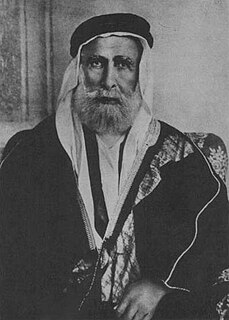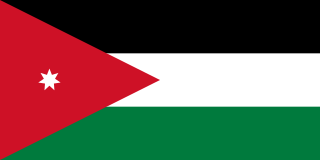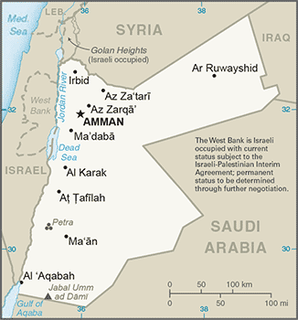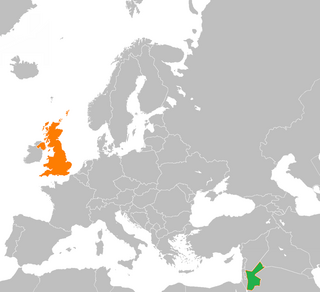The history of Jordan refers to the history of the Hashemite Kingdom of Jordan and the background period of the Emirate of Transjordan under British protectorate as well as the general history of the region of Transjordan.

The Emirate of Transjordan, officially known as the Amirate of Trans-Jordan, was a British protectorate established on 11 April 1921, which remained as such until achieving formal independence in 1946.

The Hashemites, also House of Hashim, are the royal family of Jordan, which they have ruled since 1921, and were the royal family of the kingdoms of Hejaz (1916–1925), Syria (1920) and Iraq (1921–1958). The family had ruled the city of Mecca continuously from the 10th century, frequently as vassals of outside powers, and were given the thrones of the Hejaz, Syria, Iraq and Jordan following their World War I alliance with the British Empire; this arrangement became known as the "Sharifian solution".

Abdullah I bin Al-Hussein was the founder and ruler of the Jordanian realm from 11 April 1921 until his assassination on the 20th of July 1951. He was the Emir of Transjordan, a British protectorate, until 25 May 1946, after which he was the king of an independent Jordan. As a member of the Hashemite dynasty, the royal family of Transjordan/Jordan since 1921, Abdullah was a 38th-generation direct descendant of Muhammad.

Hussein bin Ali Al-Hashimi was an Arab leader from the Banu Hashim clan who was the Sharif and Emir of Mecca from 1908 and, after proclaiming the Great Arab Revolt against the Ottoman Empire, King of the Hejaz from 1916 to 1924. At the end of his reign he also briefly laid claim to the office of Caliph. He was a 37th-generation direct descendant of Muhammad, as he belongs to the Hashemite family.

Talal bin Abdullah was the King of Jordan from the assassination of his father, King Abdullah I, on 20 July 1951 until his forced abdication on 11 August 1952. As a member of the Hashemite dynasty, the royal family of Jordan since 1921, Talal was a 39th-generation direct descendant of Muhammad.

The Jordanian annexation of the West Bank formally occurred on 24 April 1950, after the 1948 Arab–Israeli War, during which Transjordan occupied territory that had previously been part of Mandatory Palestine and had been earmarked by the UN General Assembly Resolution 181 of 29 November 1947 for an independent Arab state to be established there alongside a Jewish state mainly to its west. During the war, Jordan's Arab Legion took control of territory on the western side of the Jordan River, including the cities of Jericho, Bethlehem, Hebron, Nablus and eastern Jerusalem, including the Old City. Following the end of hostilities, the area that remained under Jordanian control became known as the West Bank.

The Hashemite Kingdom of Hejaz was a state in the Hejaz region in the Middle East that included the Levant and the western portion of the Arabian Peninsula ruled by the Hashemite dynasty. It achieved national independence in June 1916 after the destruction of the Ottoman Empire by the British Empire during the First World War when the Sharif of Mecca fought in alliance with the British Imperial forces to drive the Ottoman Army from the Arabian Peninsula during the Arab Revolt.

The modern borders of Israel exist as the result both of past wars and of diplomatic agreements between the State of Israel and its neighbours as well as colonial powers. Only two of Israel's five total potential land borders are internationally recognized and uncontested, while the other three remain disputed; the majority of its border disputes are rooted in territorial changes that came about as a result of the 1967 Arab–Israeli War, which saw Israel occupy large swathes of territory from its rivals. Israel's two formally recognized and confirmed borders exist with Egypt and Jordan since the 1979 Egypt–Israel peace treaty and the 1994 Israel–Jordan peace treaty, while its borders with Syria, Lebanon and the Palestinian territories remain internationally recognized as contested.

The history of Jews in Jordan can be traced back to Biblical times. Presently, there are no legal restrictions on Jews in Jordan, and they are permitted to own property and conduct business in the country, but in 2006 there were reported to be no Jewish citizens of Jordan, nor any synagogues or other Jewish institutions.

The Trans-Jordan Frontier Force was formed on 1 April 1926, to replace the disbanded British Gendarmerie. It was a creation of the British High Commissioner for Palestine whose intention was that the Force should defend Trans-Jordan's northern and southern borders. The TJFF was also an Imperial Service regiment whose Imperial Service soldiers agreed to serve wherever required and not just within the borders of their own colony, protectorate or, in the case of the Transjordan, mandate. This was in contrast to the Arab Legion, which was seen more as an internal security militia, deriving from the troops of the Arab Revolt and closely associated with the Hashemite cause. The Amir Abdullah was an Honorary Colonel of the Trans-Jordan Frontier Force from its inception. However, the local commanders thought it unnecessary to form an additional force, illustrated that the expansion of The Arab Legion would be a better action.

This is a survey of the postage stamps and postal history of Jordan, formerly Transjordan.
This is a timeline of major events in the history of the modern state of Jordan.

The Mandate for Palestine was a League of Nations mandate for British administration of the territories of Palestine and Transjordan, both of which had been conceded by the Ottoman Empire following the end of World War I in 1918. The mandate was assigned to Britain by the San Remo conference in April 1920, after France's concession in the 1918 Clemenceau–Lloyd George Agreement of the previously-agreed "international administration" of Palestine under the Sykes–Picot Agreement. Transjordan was added to the mandate after the Arab Kingdom in Damascus was toppled by the French in the Franco-Syrian War. Civil administration began in Palestine and Transjordan in July 1920 and April 1921, respectively, and the mandate was in force from 29 September 1923 to 15 May 1948.

Anglo-Jordanian relations refers to the relationship between the Hashemite Kingdom of Jordan and the United Kingdom of Great Britain and Northern Ireland. Both countries share a relatively close relationship because of the Hashemites, who received British help to overthrow Ottoman rule in the country during World War I. Jordan has an embassy in London. The United Kingdom has an embassy in Amman.

Independence Day The most important event in the history of Jordan is its independence from the British government.

The Occupation of Ma'an was the post-World War I occupation of the Sanjak of Ma'an, which straddled the regions of Syria and Arabia, by members of the Hashemite family, who came to power in various regions of the Near East and Arabia; they were King Hussein in the Kingdom of Hejaz, Emir Faisal representing the Arab government in Damascus and Abdullah, who was to become Emir of Transjordan. The region includes the governorates of Ma'an and Aqaba, today in Jordan, as well as the area which was to become a large part of the Israeli Southern District, including the city of Eilat.

Abdullah's entry into Transjordan on 21 November 1920 marked the beginning of the second period of Hashemite rule in the Transjordan region following a brief interregnum period. Abdullah, the second son of Sharif Hussein, arrived from Hejaz by train in Ma'an in southern Transjordan on 21 November 1920 to redeem the Kingdom his brother had lost. Transjordan then was in disarray and widely considered to be ungovernable with its dysfunctional local governments.

The Jordan–Saudi Arabia border is 731 km in length and runs from the Gulf of Aqaba in the south-west to the tripoint with Iraq in the north-east.

















